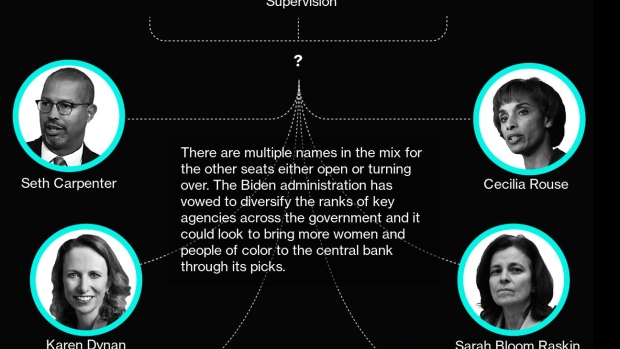Sep 9, 2021
Biden’s Opportunity to Reshape the Federal Reserve
, Bloomberg News

(Bloomberg) -- President Joe Biden has an opportunity this fall to reshape the Federal Reserve, potentially ushering in an era in which the U.S. central bank’s governing board will have more women and people of color and those who would put more weight on reducing economic inequality.
The members of the Fed board face the ongoing challenge of repairing the U.S. economy from damage caused by the coronavirus pandemic. They’ll be tasked with deciding when to pull back support for the recovery and when to raise interest rates from the rock-bottom levels that have fueled a housing boom and sent stocks soaring to record highs since last year.
Progressive Democrats are urging the Biden administration to shape Fed leadership so that the central bank uses its tools to better promote job gains across racial groups, keep Wall Street banks in check and combat climate change. The president himself has made a more equitable labor market a centerpiece of his agenda.
“It is about justice,” Biden said in a campaign speech last July. “For generations, Americans who are Black, Brown, Native American, immigrant, haven't always been fully included in our democracy or our economy.”
The current board of Fed governors has six members and an open seat. Each is picked by the president and then subject to Senate confirmation. Powell was nominated to the board by former President Barack Obama and then elevated to the chair position by former President Donald Trump.
Biden has a chance to fill the positions of chair, vice chair, vice chair of supervision and the vacant board seat. Bloomberg has reported that Biden’s advisers are considering recommending that Biden give Powell another four years as Fed chair and pair that with the nomination of Fed Board Governor Lael Brainard for the central bank’s chief regulator role, which is opening up in October.
The most anticipated pick is the chair. Many economists expect Biden to resume a decades-long tradition of reappointing a presidential predecessor’s Fed chief — in a nod to the central bank’s independence from the White House — by giving Powell a second, four-year term. Trump broke the pattern in elevating Powell, then a Fed governor, to chair in 2018 rather than giving Janet Yellen, now Treasury secretary, a second term as Fed chair.
While Powell has been seen as the most likely pick, some progressive activists have been urging Biden to pick Brainard instead, given her opposition to deregulation moves under Powell. They note the chair controls the agenda, diminishing the vice chair’s power if they aren’t aligned with the chair.
For the other potential openings, Fed watchers consider multiple people from current and former Fed policy makers to academics and a Wall Street economist as contenders.
Many of them held posts in the Obama administration at the Fed, Treasury Department or Council of Economic Advisers including Lisa Cook, Sarah Bloom Raskin, Karen Dynan and Seth Carpenter.
William Spriggs, chief economist at the AFL-CIO labor federation, is an outspoken advocate for pro-worker policies across racial groups. And Cecilia Rouse is currently the first African-American to chair the White House Council of Economic Advisers, a position also held by Ben Bernanke and Yellen before they became Fed chairs.
Biden is expected to weigh in on at least the pick for Fed chair this fall, in order to complete the Senate confirmation process ahead of the February deadline. Multiple people are in play for upcoming roles at the Fed, and a lot could change in the deliberations — and economy — before he does.
©2021 Bloomberg L.P.